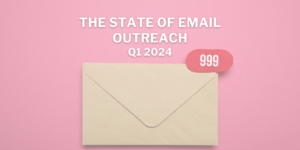
The State of Email Outreach: Q1 2024
Email in Q1 2024 is still going strong. I started working in marketing in 2012 and, in my first week on the job, attended a panel on the death of email. Three marketing directors, what I aspired to be, sat on an overlit convention hall stage to discuss why email was on its way out the door. Because “Millennials only cared about Snapchat and Instagram, consumers were increasingly numb to their inboxes and targeted digital ads would be the wave of the future.”
Over a decade later, those panelists probably took the link to that video recording off of their websites, but email remains. Of course, it has gone through dozens of evolutions over the years thanks to the increase in consumer protection privacy laws like GDPR and CCPA compliance. However, these restrictions can be a good change for email. When consumers know how a brand accessed their information, or, even better, that they provided it themselves, they’re more likely to engage with the content. Why? Because they chose it. High engagement from a concentrated yet interested group beats sending thousands of emails to collect dust in spam folders every time.
Check out these seven tips for sending an introductory message and improve the state of your email in Q1 2024:
1) Focus on the subject line
Subject lines are extremely important to the open rate of an email and the effectiveness of getting your point across. Only 14% of emails without a subject line are opened. Typically, subject lines with 3-4 words received the most responses. However, if an extra word adds clarity, go ahead and include it. Personalized and clear subject lines can increase email open rates by 16% and reply rates by 3%.
2) Briefly introduce yourself
Even if the person receiving the email is aware of who you are, sometimes a specific email address is hard to recognize. Start off with a brief background on you and your relationship. Then, clarify why you’re reaching out including goals and next steps.
3) Maintain privacy
Don’t be afraid to use the BCC tool. When working with a third party, don’t give their addresses away freely just for the means of communication within a larger group. Always air on the side of caution when it comes to respecting the privacy of others.
4) Write with emotion
Another significant factor in determining your email’s response rate is how positive or negative the message is. Emails that are slightly to moderately positive or slightly to moderately negative elicit 10-15% more responses than emails that are completely neutral. As long as you avoid going too far on the positive or negative spectrum, write a little toward either side.
5) Ask questions
But, don’t go overboard. Studies show that an email with three questions is 20% more likely to get a response than an email with eight or more. Questions are most effective when the reader’s answer is likely to be yes “yes,” so make sure the first question will keep them reading.
6) Watch your length
Of course, this will differ and doesn’t need to be exact, but typically messages ranging between 50-125 words yield a response rate of more than 50%. If you need to include 2000+ words, it’s better to add the meat of your content as an attachment. Remember, as the sender, your email is a personal reflection. Seemingly small language issues such as word choice, punctuation, tense and so much more can make or break the success of an email in 2024.
7) Always include a signature
Neglecting to use a signature discounts your message and can make you seem like an amateur. Less is more when it comes to a professional sign-off, so keep it simple with clear contact information and a headshot. Headshots put a face to what would otherwise just be a wall of text. Please, a photo communicates eye contact (something we’re all missing lately!) and personality, making the request harder to reject.
You don’t want to be the reason email finally died.




